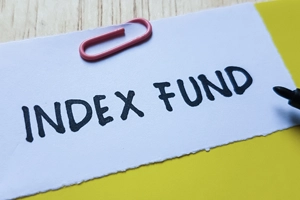
Index funds represent a passive form of investing. These funds follow a benchmark index and invest in the same companies that make up the index. This approach results in fewer trades, lower costs and returns that closely mirror the market. To invest wisely in index funds, it helps to understand the benchmarks behind them. This article will compare two popular indices in India — the NIFTY 50 and the NIFTY 500. Let's understand their difference and see if there is a winner in the competition of NIFTY 50 vs NIFTY 500.
What is NIFTY 50?
The NIFTY 50 is a benchmark index that tracks the performance of the top 50 listed companies on the National Stock Exchange of India (NSE). Launched in 1996, it includes stocks from companies across key sectors and accounts for roughly 55.48% [1]of the total free-float market capitalisation on the NSE.
What is NIFTY 500?
The NIFTY 500 is a benchmark index that includes the top 500 listed companies on the NSE. These companies have been chosen from 72 different sectors and cover nearly 93% of the free-float market capitalisation on the exchange.
NIFTY 500 vs NIFTY 50 – Understanding the differences
Here is a detailed look at some differences between NIFTY 50 and NIFTY 500:
- Eligibility
The NIFTY 50 includes the top 50 large-cap companies listed on the NSE. A company must be actively traded on the exchange and included in the Futures & Options (F&O) segment to be eligible. It should have a minimum listing history of six months, a low impact cost of 0.50% or less for trades of ₹ 10 crore in at least 90% of the observations, and a free-float market capitalisation that is no less than 1.5 times the average of the smallest current constituent[2].
On the other hand, the NIFTY 500 covers a much broader set of companies. A company must be listed on the NSE and rank within the top 800 based on full market capitalisation to qualify. The stock must be traded on at least 90% of the trading days in the past six months. Instruments such as convertible securities, preferred shares, and warrants that carry a fixed return are excluded from the index.
[1] https://www.niftyindices.com/indices/equity/broad-based-indices/nifty--50
- Types of companies
The NIFTY 50 represents India's most prominent companies. These companies have a demonstrated history of stable earnings and enjoy a good market reputation.
In contrast, the NIFTY 500 offers exposure to all types of companies, including large-cap, mid-cap, and small-cap companies across 72 different sectors. These may include emerging businesses that are not part of NIFTY 50 as well as established companies that are a part of NIFTY 50.
- Diversification
While the NIFTY 50 does offer sectoral diversification among large-cap stocks, the NIFTY 500 provides a much broader and deeper level of diversification. With 500 stocks in its portfolio, the index invests in approximately 93% of the total free-float market capitalisation of NSE-listed [3]stocks. However, it is important to note that an index consisting of 500 stocks may also be seen as over-diversification by some investors and financial experts.
- Risk
NIFTY 50 carries comparatively lower risk, as it focuses on large-cap companies that are well-established. NIFTY 500, on the other hand, has a relatively higher risk. It includes a broader mix of companies with large, mid, and small-cap stocks across various sectors and industries.
[2] https://economictimes.indiatimes.com/markets/stocks/news/nifty50-rejig-trent-bharat-electronics-added-ltimindtree-divis-exit-index/articleshow/112742982.cms?from=mdr
[3] https://www.livemint.com/mutual-fund/your-questions-answered-how-is-the-nifty-500-index-different-from-nifty-50-please-elaborate-mutual-funds-index-funds-11713867385568.html
Which benchmark suits your investment goals?
Choosing between the NIFTY 50 and NIFTY 500 depends largely on your investment goals and risk appetite.
If you are looking for stability and exposure to prominent companies listed on the NSE, the NIFTY 50 may be a good fit. It comprises well-established players with a track record of performance.
However, if you are seeking broader market exposure, the NIFTY 500 can offer a more diversified option. It includes all the NIFTY 50 companies, so you do not miss out on the top players. But it also includes 450 additional stocks, including 50 more large-caps from the NIFTY 100 and 400 others that comprise mid- and small-cap companies. These 400 companies, ranked 101 to 500, represent around 27% of the NIFTY 500's total weight. The remaining 73% is dominated by the top 100 stocks, including the NIFTY 50[4].
Essentially, investing in the NIFTY 500 gives you access to the entire NIFTY 50. However, the weightage will differ.
Conclusion
It helps to align the index fund you choose with your investment horizon and risk preferences. It is wise to carefully understand and compare the differences, and if needed, consult a financial advisor who can help match the right benchmark to your specific needs.
An investor education initiative by Edelweiss Mutual Fund
All Mutual Fund Investors have to go through a one-time KYC process. Investors should deal
only with Registered Mutual Fund (RMF). For more info on KYC, RMF and procedure to lodge/redress any complaints, visit - https://www.edelweissmf.com/kyc-norms
MUTUAL FUND INVESTMENTS ARE SUBJECT TO MARKET RISKS. READ ALL SCHEME-RELATED DOCUMENTS CAREFULLY
Trending Articles
MUTUAL FUND INVESTMENTS ARE SUBJECT TO MARKET RISKS, READ ALL SCHEME RELATED DOCUMENTS CAREFULLY.















